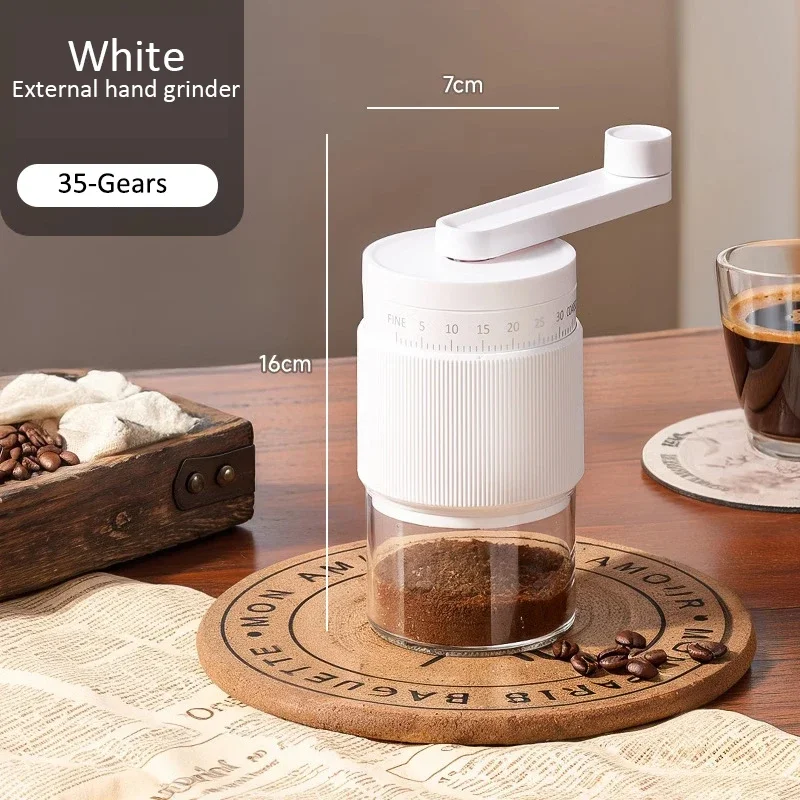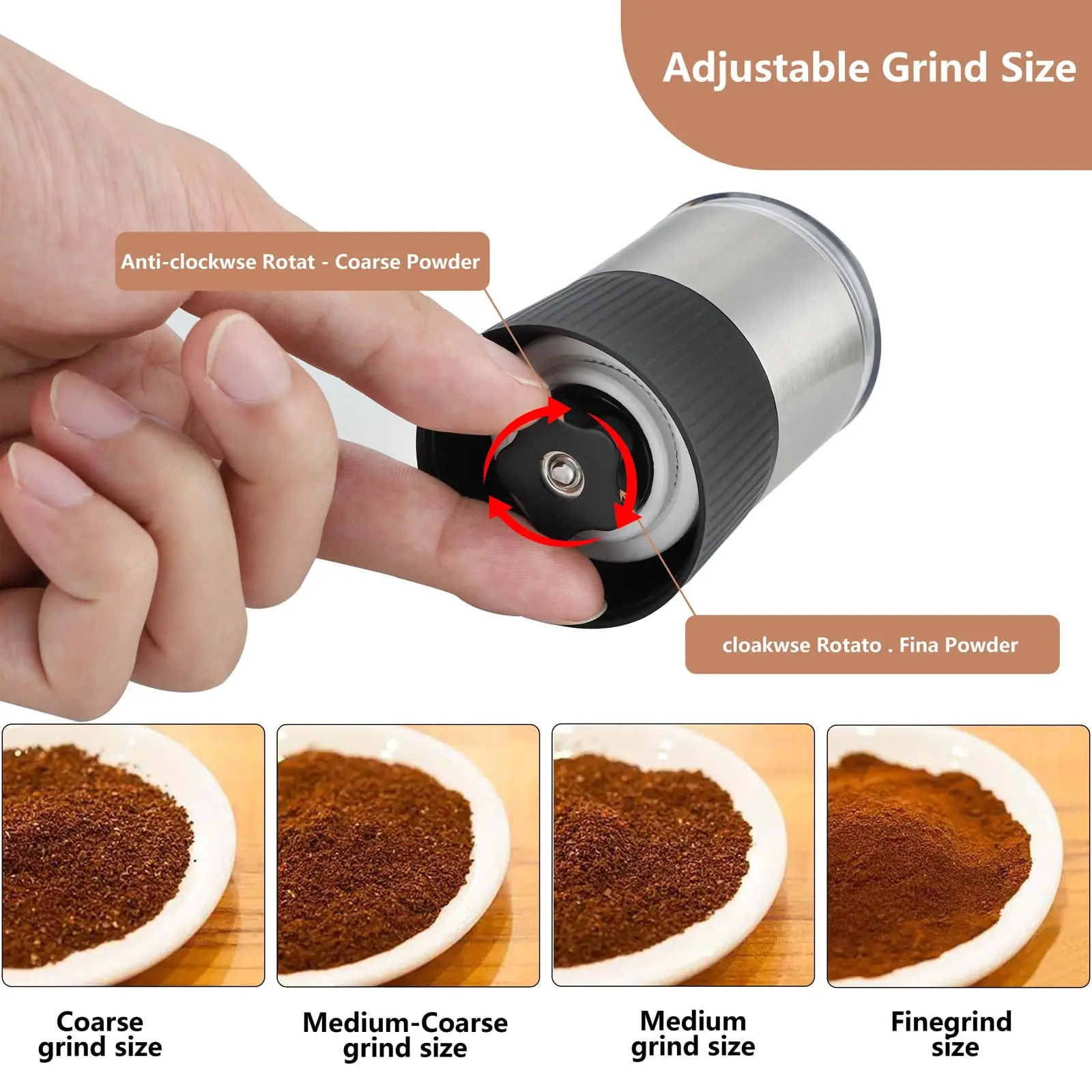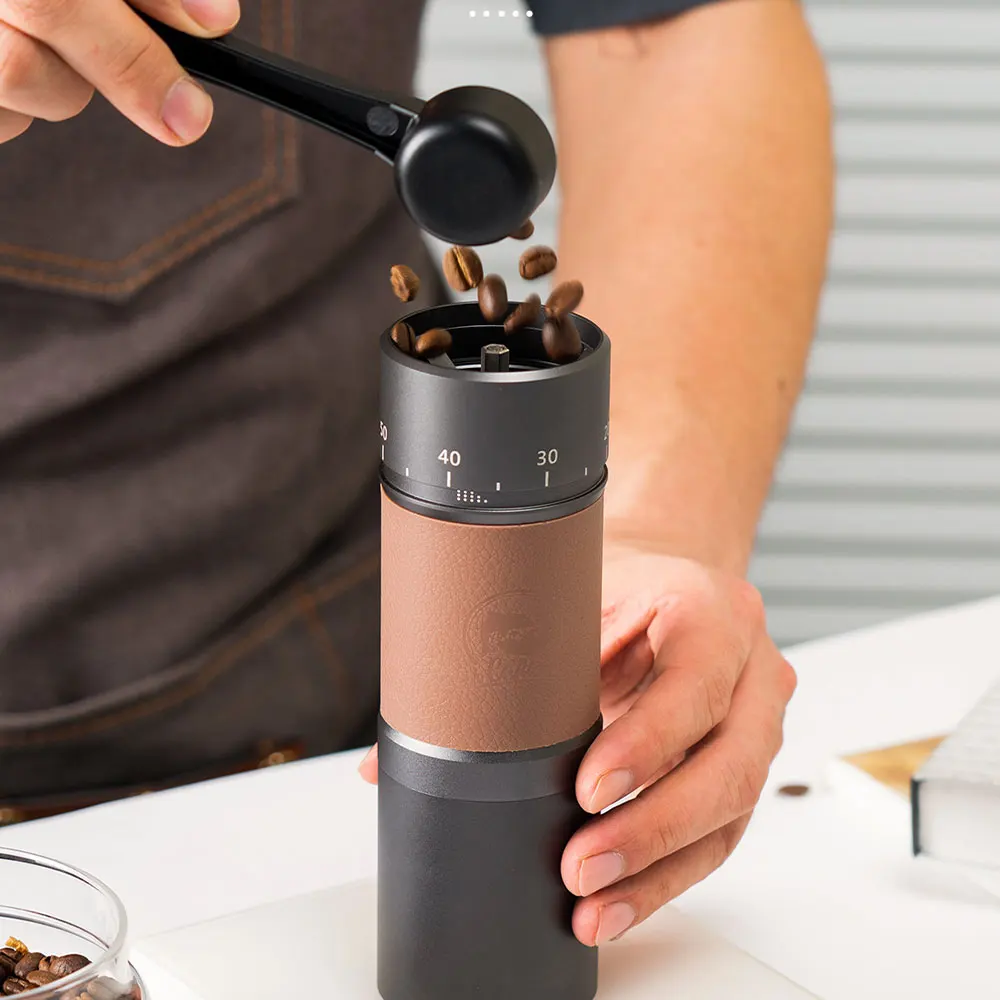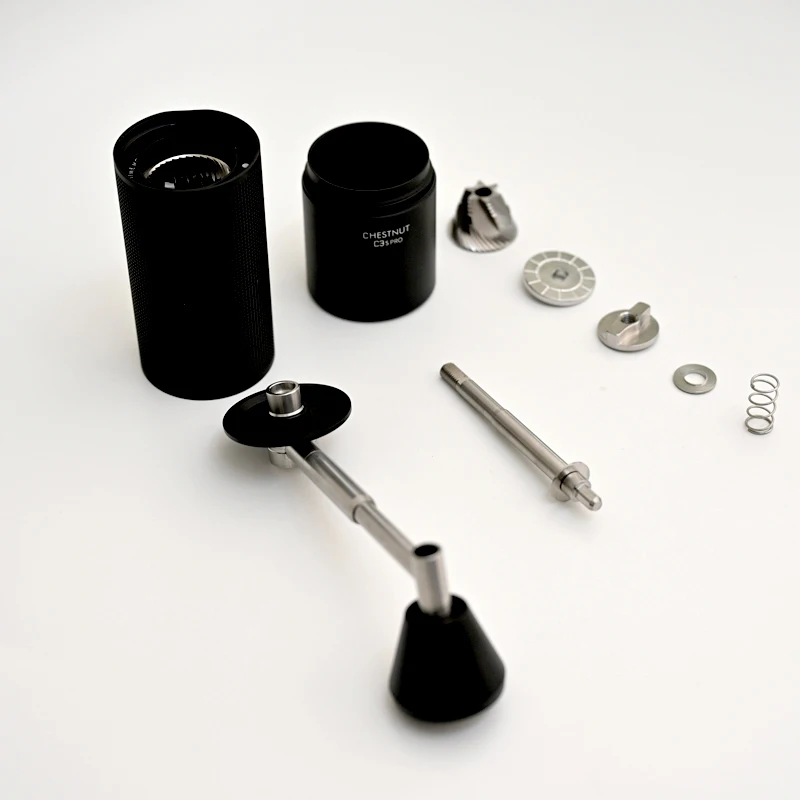Understanding the Critical Relationship Between Grinder Design and Mobile Brewing Success
Coffee brewing on the go presents unique challenges that demand specialized equipment. When it comes to mobile coffee experiences, the design of your grinder isn’t just about convenience—it’s the determining factor between a mediocre cup and an exceptional brew.
Fresh grinding is particularly crucial in mobile settings. Studies show that ground coffee begins losing its aromatic compounds within 15 minutes, with up to 60% of flavors degrading within half an hour. This flavor loss happens even faster when exposed to changing environments common during travel. Simply put, pre-ground coffee can’t deliver the quality experience that freshly ground beans provide, especially when brewing outdoors or away from home.
The connection between grinder design and mobile brewing success extends across various scenarios:
- Personal travel brewing (hiking, camping, road trips)
- Office or commuter setups (compact yet effective daily solutions)
- Small commercial operations (coffee carts, pop-up cafés, events)
- Van life and long-term travel brewing stations
The right portable grinder bridges the gap between convenience and quality, allowing for understanding the importance of fresh grinding for quality coffee without compromise. The carefully engineered features of a quality portable grinder directly impact extraction, flavor clarity, and brewing consistency—especially important when other variables (water quality, brewing conditions) may already be challenging during travel.
When evaluating portable grinder options for mobile brewing, understanding the design principles that enhance performance while maintaining mobility becomes essential for anyone serious about quality coffee away from home.
Core Design Elements That Define Superior Portable Grinders
The difference between frustrating coffee experiences on the go and consistently excellent brews comes down to seven fundamental design elements that work together to create truly effective portable grinding solutions:
- Size & weight engineering
- Durability construction
- Grind consistency mechanisms
- Power solutions (for electric models)
- Capacity optimization
- Ergonomic considerations
- Component quality and materials
These elements require careful balance—improving one often means compromising another. For example, maximizing durability typically increases weight, while enhancing grind consistency might require larger adjustment mechanisms that impact portability. The most successful portable grinders achieve an optimal balance based on their intended use case, whether that’s ultralight backpacking or mobile coffee cart operations.
Size & Weight Engineering: Achieving Maximum Portability
Effective portable grinder design begins with careful material selection to minimize weight while maintaining functionality. The weight spectrum for portable grinders typically ranges from ultralight options (under 8 oz/227g) to standard portable models (under 16 oz/454g).
Material choices directly impact both weight and durability:
– Aluminum alloys offer excellent weight-to-strength ratios, making them ideal for frame components
– Stainless steel provides superior durability but adds weight, commonly used for burrs and critical structural elements
– High-quality polymers reduce weight in non-critical components without sacrificing performance
Innovative form factors further enhance portability through:
– Cylindrical designs that distribute weight efficiently
– Collapsible or folding handles that reduce packed dimensions
– Nested component systems that eliminate wasted space
Some of the most travel-friendly designs integrate directly with other brewing equipment—like grinders sized to fit inside an AeroPress chamber—effectively reducing the overall space required in a travel setup. These specialized grinders designed for maximum portability showcase how thoughtful engineering can dramatically improve the mobile coffee experience without compromising grind quality.
Durability Construction for Travel Resilience
Travel conditions present unique challenges for coffee equipment. A grinder that performs flawlessly on a kitchen counter may quickly develop issues when subjected to the rigors of travel—impacts, vibrations, temperature fluctuations, and moisture exposure.
Key vulnerability points in portable grinders include:
– Bearing systems that can misalign under impact
– Adjustment mechanisms that can slip or wear
– Connection points between components that loosen with repeated assembly/disassembly
– Burrs that can chip or dull when subjected to vibration
Superior durable grinders built to withstand travel conditions address these vulnerabilities through reinforced mounting points, sealed bearings, and careful material selection. Stainless steel offers excellent impact resistance and corrosion protection but adds weight. High-grade aluminum provides good durability with weight savings but may dent under significant impact. Reinforced polymers offer the best weight-to-durability ratio for non-critical components.
Environmental considerations further differentiate travel-optimized designs. Grinders intended for outdoor use often feature sealed adjustment mechanisms and moisture-resistant construction—particularly important for humid environments or when brewing in morning dew conditions common during camping.
Grind Consistency Engineering & Adjustment Mechanisms
The true measure of any coffee grinder is the consistency of its output—even more critical in mobile settings where other brewing variables may already be challenging to control. Achieving consistency in portable designs requires specialized engineering approaches.
Burr design in portable grinders typically favors conical over flat configurations due to:
– More efficient use of limited space
– Better performance with manual power input
– Simpler alignment maintenance during travel
Material selection for burrs presents important tradeoffs:
– Ceramic burrs: Lightweight, stay sharp longer, but brittle and can chip during travel
– Steel burrs: More durable for travel, slight weight penalty, may require occasional maintenance
Adjustment mechanism design varies widely, with premium portable grinders offering 15-45+ distinct settings to accommodate everything from espresso (200-400 microns) to French press (1000-1200 microns). Understanding reference for optimal grind sizes for different brewing methods helps users maximize their grinder’s capabilities.
The most travel-worthy adjustment systems feature:
– External adjustment for quick changes without disassembly
– Positive click settings that resist slipping during transport
– Calibration systems that maintain consistency despite repeated assembly/disassembly
– Wide adjustment ranges suitable for multiple brewing methods

Power Solutions for Electric Portable Grinders
While manual grinders dominate the truly portable market, significant advances in battery and motor technology have made electric portable grinders increasingly viable for mobile brewing scenarios.
Modern portable electric grinders feature:
– Lithium-ion batteries (2000-3000 mAh) capable of grinding 30-40g of coffee per charge
– Efficient brushless motors that maximize battery life
– USB-C charging capabilities for universal power access
– Compact designs approaching the size of premium manual grinders
When comparing powered vs manual grinding approaches, the tradeoff between convenience and absolute portability becomes apparent. Electric models offer faster grinding with less physical effort but require charging, weigh more, and introduce more potential failure points in challenging environments.
For semi-mobile setups like van life or small coffee carts, electric grinders with efficient power management systems provide the best balance of convenience and performance. For true “off-grid” scenarios, manual options remain superior due to their independence from power sources.
Capacity Optimization for Mobile Use
Capacity requirements vary dramatically based on the intended mobile brewing scenario:
– Solo travelers typically need 15-20g capacity per brew
– Small groups require 30-40g capabilities
– Mobile commercial operations may need multiple 50g+ batches in quick succession
Effective portable designs address these varying needs through:
– Single-dose grinding systems that minimize waste and simplify cleaning
– Modular hoppers that can be configured for different capacity requirements
– Secure grounds collection containers that prevent spillage during travel
– Efficient transfer systems from grinder to brewing device
The most versatile portable grinders achieve optimal capacity without significantly increasing their dimensions, often through clever internal compartment design rather than overall size increases.
Ergonomics & User Experience in Mobile Environments
Grinding coffee in mobile settings—whether on uneven surfaces, in confined spaces, or with limited stability—presents unique ergonomic challenges that home grinders rarely need to address.
Travel-optimized grinders with ergonomic features optimized for travel use incorporate:
– Non-slip base materials that provide stability on varied surfaces
– Handle designs that accommodate different gripping positions
– Comfortable grip materials that perform well in variable weather conditions
– Intuitive assembly/disassembly that doesn’t require tools or complex procedures
Field cleaning capabilities represent another critical aspect of mobile grinder ergonomics. The best designs allow for quick, thorough cleaning with minimal water and no specialized tools—an essential consideration when brewing far from typical kitchen amenities.
Manual Grinder Designs: Engineering for Ultimate Mobility
Manual grinders represent the pinnacle of portable coffee equipment, offering several fundamental advantages in mobile contexts:
– Complete independence from power sources
– Lighter weight than comparable electric options
– Fewer components that could fail during travel
– Often more compact dimensions
– Superior performance-to-weight ratio
The engineering behind premium manual burr grinders ideal for mobile brewing setups has advanced significantly in recent years. Modern designs incorporate dual bearing systems, stabilized central shafts, and precision-machined components that deliver consistency approaching commercial electric grinders while maintaining travel-friendly dimensions.
Key performance differentiators in high-quality manual grinders include:
– Bearing quality and placement (dual bearings offer superior stability)
– Burr alignment mechanisms that maintain precision despite travel conditions
– Handle design for efficient power transfer and ergonomic comfort
– Connection thread quality that maintains integrity during repeated assembly
While manual grinding requires physical effort, the latest designs with optimized burr geometry and improved bearing systems have dramatically reduced the force required while improving consistency—making manual grinding increasingly accessible even for those who previously preferred electric options.

Electric Portable Grinder Designs: Balancing Convenience and Mobility
The engineering challenges in creating truly portable electric grinders are substantial, requiring careful balance between power, performance, and packability. Recent innovations have produced increasingly viable electric options for mobile brewing scenarios.
Modern portable electric grinders feature:
– Compact brushless motors (3-5W) that maximize efficiency
– Lithium-ion batteries optimized for grinding torque rather than longevity
– Simplified user interfaces focused on core functionality
– Conical burr systems optimized for battery-powered operation
When evaluating electric portable options, key performance metrics include:
– Grinds per charge (typically 30-50g for premium models)
– Grinding speed (30-45 seconds for a standard 18g dose)
– Noise levels (important in shared travel settings)
– Charging flexibility (USB-C has become the standard)
Electric and manual grinders suitable for outdoor brewing offer different advantages depending on the specific mobile brewing context. Electric models excel in scenarios with regular access to charging, where speed and convenience take priority over absolute portability and reliability.
Matching Grinder Design to Your Mobile Brewing Context
Different mobile brewing scenarios place unique demands on grinder design, requiring careful matching of features to specific use cases:
Wilderness/Ultralight Applications:
– Priority: Minimum weight and maximum durability
– Optimal design: Compact manual grinders with aluminum construction
– Key features: Tool-free disassembly, weather resistance, minimal packed size
Commuter and Office Brewing:
– Priority: Convenience and cleanliness
– Optimal design: Compact electric or manual with contained grounds chamber
– Key features: Quick operation, minimal noise, easy cleaning
Vehicle-Based Mobile Brewing:
– Priority: Versatility and consistency
– Optimal design: Premium manual or rechargeable electric grinders
– Key features: Wide grind range, larger capacity, stability base for in-vehicle use
Small Commercial Mobile Operations:
– Priority: Speed, consistency, and reliability
– Optimal design: Battery-powered electric with commercial-grade components
– Key features: Extended capacity, quick adjustment, battery longevity
Specialized manual grinders for different brewing contexts demonstrate how specific design elements can be optimized for particular use cases, from espresso-focused precision to wilderness durability.
Fine Adjustment Hand Grinder, Precision Manual Grinder, Travel Coffee Grinder
Price range: $185.11 through $494.63 Select options This product has multiple variants. The options may be chosen on the product pageHand Burr Grinder, Hand Crank Coffee Grinder, Manual Espresso Grinder, Portable Coffee Grinder
Price range: $262.72 through $300.22 Select options This product has multiple variants. The options may be chosen on the product pageManual Burr Mill, Manual Coffee Grinder Stainless Steel, Manual Coffee Mill Grinder, Mechanical Coffee Grinder
Price range: $127.26 through $130.32 Select options This product has multiple variants. The options may be chosen on the product pageHand Burr Grinder, Manual Coffee Grinder Stainless Steel, Precision Manual Grinder
Price range: $183.64 through $187.52 Select options This product has multiple variants. The options may be chosen on the product page
Critical Component Analysis: How Design Details Impact Performance
While overall design philosophy determines a grinder’s suitability for mobile use, the specific engineering of individual components directly impacts real-world performance. Understanding these components helps users make informed selections and properly maintain their equipment in travel situations.
The interaction between components creates a system where the quality of each element affects overall performance—a grinder with exceptional burrs but poor bearing alignment will produce inconsistent results, while perfect alignment with inferior burrs cannot overcome the fundamental limitations of the cutting surfaces.

Burr Engineering: Geometry and Materials
At the heart of every quality grinder is its burr set—the component most directly responsible for grind quality and consistency. In portable designs, burrs face additional constraints compared to their larger counterparts.
Portable-specific burr considerations include:
– Size limitations (typically 38-48mm diameter compared to 50-75mm in home grinders)
– Weight restrictions favoring optimized geometry over simply larger cutting surfaces
– Material selection balancing edge retention with travel durability
The debate between conical and flat burrs takes on different dimensions in portable contexts. While flat burrs theoretically offer more uniform particle distribution, conical designs provide several advantages for mobile use:
– More efficient use of limited space
– Better performance with manual power input
– Typically lighter weight for similar performance
– Simpler alignment maintenance during travel
Among grinders with various burr designs and materials, material selection significantly impacts both performance and durability. Stainless steel burrs provide excellent durability for travel conditions but may generate slightly more heat during grinding. Ceramic offers exceptional edge retention but introduces brittleness concerns during travel. Titanium-coated options present an emerging middle ground, offering enhanced durability and edge retention, though at a higher cost.
Grind Adjustment Mechanisms: Precision Engineering in Small Spaces
Creating precise, repeatable adjustment systems within the constraints of portable design requires innovative engineering approaches. The best portable grinders achieve remarkable precision despite their compact dimensions.
Common adjustment approaches include:
– Stepped systems with distinct click positions (typically 15-45 settings)
– Hybrid stepped/stepless designs offering micro-adjustments between clicks
– Full stepless systems allowing infinite adjustment (more common in premium models)
For travelers using multiple brewing methods, understanding guidance on adjustment mechanisms for consistent results becomes essential, as different brewing techniques require specific grind profiles that may change with environmental conditions.
Adjustment stability during travel represents a particular challenge. Premium designs incorporate:
– Locking systems that prevent unintended adjustment during transport
– Anti-backlash mechanisms that maintain setting precision
– Calibration capabilities that allow realignment if components shift during travel
The finest portable adjustment systems achieve a remarkable 15-20 microns of adjustment precision—approaching commercial grinder capabilities while maintaining travel-friendly dimensions.
Body Construction: Material Selection and Design Impact
The grinder body serves multiple critical functions beyond simply housing the internal components:
– Providing structural alignment for the grinding mechanism
– Protecting internal components from impact and environmental factors
– Offering ergonomic interfaces for user operation
– Establishing the foundation for consistent performance
Material selection directly impacts durability, weight, and performance stability:
– Stainless steel bodies offer unmatched durability and stability but maximum weight
– Aluminum provides excellent strength-to-weight ratio with good impact resistance
– Polymer/metal hybrids offer strategic reinforcement at minimal weight penalty
Connection methods between body components significantly affect long-term durability:
– Precision threading with fine pitch provides secure connections that resist vibration
– Metal-to-metal mating surfaces maintain alignment better than metal-to-plastic
– Strategic reinforcement at high-stress junctions prevents wear during repeated assembly
The most travel-worthy designs incorporate field-serviceable body components that can be maintained without specialized tools—an essential consideration for extended travel use.
Bearing and Shaft Systems: The Hidden Performance Factor
Perhaps the most overlooked yet critical component in portable grinder design is the bearing and shaft system, which directly impacts grinding consistency, effort required, and long-term durability.
Premium portable grinders feature:
– Dual bearing systems that stabilize the central shaft from both ends
– Precision-machined shafts with minimal runout (typically under 0.1mm)
– Sealed bearings that resist contamination from coffee particles and environmental factors
– Self-aligning designs that maintain performance despite travel conditions
The performance difference between single and dual bearing systems becomes particularly apparent in travel scenarios, where alignment issues are more common. Dual bearing designs maintain consistency even when subjected to the lateral forces common during manual grinding, while single bearing systems may develop wobble that creates inconsistent particle size.
Selection Framework: Matching Grinder Design to Your Mobile Coffee Needs
Finding the ideal portable grinder requires a systematic approach that prioritizes features based on your specific mobile brewing context. Consider these key questions to guide your selection:
What is your primary brewing method?
– Espresso requires finer adjustment capability and higher precision
– Filter methods benefit from consistency in medium-to-coarse ranges
– Multiple brewing methods demand wider adjustment ranges
How will you transport and use the grinder?
– Ultralight backpacking prioritizes minimum weight and packed size
– Vehicle-based travel allows for slightly larger but more capable options
– Office/commuter use emphasizes clean operation and quick workflow
How frequently will you grind away from home?
– Daily use demands higher durability and easier maintenance
– Occasional use may allow more focus on optimal performance for specific scenarios
What is your typical dose size and frequency?
– Solo brewing (15-20g doses) works with most portable options
– Group brewing (multiple 30g+ doses) benefits from larger capacity
– Commercial applications require focus on speed and consistency
By systematically addressing these questions, you can identify the design elements most critical for your specific mobile brewing needs, allowing for an informed selection that balances the inevitable tradeoffs in portable grinder design.
Field Maintenance: Preserving Grinder Performance While Mobile
Maintaining grinder performance during travel requires different approaches than home maintenance routines. A simple field maintenance strategy preserves consistency and extends equipment life.
Essential field maintenance practices include:
– Regular dry brushing of burrs after each use (soft bristle brushes work best)
– Periodic deep cleaning using dry rice or specialized grinder cleaning tablets
– Inspection of bearing performance by testing for shaft play or resistance
– Thread cleaning and occasional food-safe lubrication for frequently disassembled connections
A minimalist travel maintenance kit should include:
– Small brush with firm bristles (repurposed makeup brushes work well)
– Microfiber cloth for external cleaning
– Small container of grinder cleaning tablets or instant rice packets
– Optional: small tube of food-safe lubricant for extended trips
Preventative practices significantly extend performance between thorough cleanings:
– Allow grinders to acclimate to ambient temperature before use (prevents condensation)
– Store in breathable containers rather than airtight cases when possible
– Avoid grinding excessively oily beans when thorough cleaning isn’t possible
– Use the adjustment mechanism regularly to prevent setting from becoming stuck
Is Bluetooth Connection Necessary for Modern Portable Grinders?
While smart features are increasingly common in home coffee equipment, their utility in portable grinders deserves careful consideration. For most mobile brewing scenarios, Bluetooth connectivity and app integration offer limited practical benefits while introducing several disadvantages:
Potential Benefits:
– Precise recipe storage between brewing locations
– Detailed grinding records for coffee journaling
– Remote operation (though rarely practical in mobile contexts)
Significant Drawbacks:
– Reduced battery life (15-25% decrease in typical models)
– Additional failure points in challenging environments
– Unnecessary complexity for most mobile brewing scenarios
– Increased cost without proportional performance improvement
For truly mobile applications (hiking, travel, etc.), traditional mechanical adjustment systems provide better reliability, battery life, and field serviceability. Bluetooth features make more sense in semi-permanent mobile setups like van life configurations or small commercial operations where data tracking offers genuine value.
Emerging Innovations Shaping the Future of Portable Grinding
The portable grinder market continues to evolve rapidly, with several emerging technologies poised to significantly impact mobile brewing capabilities:
Advanced Materials Science:
– Carbon fiber composites offering unprecedented strength-to-weight ratios
– Self-lubricating ceramic bearings that maintain performance without maintenance
– Burr coatings that dramatically extend edge retention while reducing particle adhesion
Power System Evolution:
– Ultra-efficient motors requiring 30-40% less power for the same output
– Rapid-charge battery systems achieving 80% capacity in under 15 minutes
– Solar integration for extended off-grid operation
Sustainability Initiatives:
– Modular designs enabling component replacement rather than full product replacement
– Biodegradable or compostable materials for non-critical components
– Carbon-neutral manufacturing processes reducing environmental impact
These innovations suggest a future where portable grinders will continue closing the performance gap with their full-size counterparts while further reducing weight and increasing durability—making quality coffee increasingly accessible in even the most challenging mobile environments.
Does Hand Grinding Actually Produce Better Coffee When Traveling?
The question of whether manual grinding produces superior results in travel situations extends beyond simple preference to practical performance differences in mobile contexts.
From a purely extraction perspective, properly designed manual and electric grinders can produce equally consistent grounds when new and properly maintained. However, several factors often give manual grinders an edge in mobile scenarios:
- Manual grinders generate less heat during operation—particularly important when grinding for heat-sensitive methods like cold brew during summer travel
- The direct physical connection provides immediate feedback about bean hardness and grinding progress
- Manual operation eliminates battery anxiety and charging concerns
- Simpler mechanisms typically maintain calibration better during transport
The most significant advantage may be reliability—manual grinders simply have fewer components that can fail in challenging environments. For travelers prioritizing consistent quality in unpredictable situations, the reliability advantage often outweighs the convenience benefits of electric options.
Why Premium Portable Grinders Are Worth the Investment
The substantial price difference between basic and premium portable grinders often raises questions about value, particularly when comparing $30-40 entry-level options with $150-250 premium models. This difference represents more than marketing—it reflects fundamental design and manufacturing approaches that directly impact the brewing experience.
Premium portable grinders justify their investment through:
Extended Usable Lifetime: Quality portable grinders typically maintain performance for 5-8+ years of regular use compared to 1-2 years for budget options—effectively reducing the long-term cost per use despite higher initial investment.
Consistency Maintenance: Premium models retain their adjustment precision and grind consistency even after extensive travel use, while budget options typically show significant performance degradation within months.
Experience Enhancement: The tangible improvement in coffee quality—particularly for brewing methods sensitive to grind consistency like pour-over and espresso—provides daily value that accumulates with each use.
Adaptability Across Methods: Higher-end portable grinders offer the adjustment precision and consistency to work effectively across brewing methods, eliminating the need for method-specific equipment when traveling.
At Savor Suite, we’ve observed that customers who invest in quality portable grinding equipment typically experience greater satisfaction with their mobile coffee experiences and ultimately spend less over time by avoiding the replacement cycle common with lower-quality alternatives.
The ultimate value proposition of premium portable grinders lies in their ability to transform mobile coffee brewing from a compromise to an experience that matches or even exceeds home brewing quality—bringing exceptional coffee to wherever your adventures take you.







